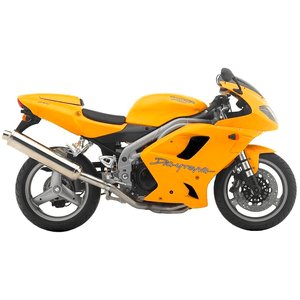Triumph Daytona 955i (2002-2006): A Triple-Cylinder Icon Revisited
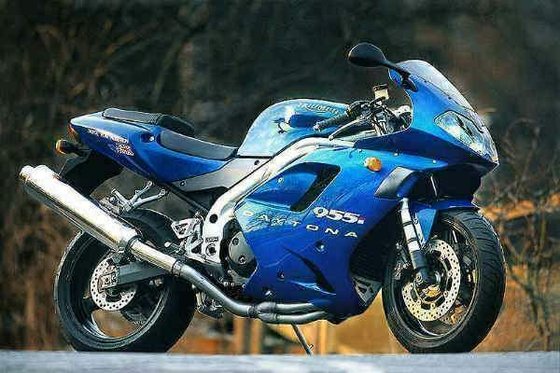
Introduction
The Triumph Daytona 955i isn’t just a motorcycle—it’s a statement. Born during a time when Japanese inline-four engines dominated the superbike scene, this British underdog dared to be different. From 2002 to 2006, the Daytona 955i carved its niche with a howling 955cc triple-cylinder engine, razor-sharp handling, and a design that balanced aggression with sophistication. Riding one today feels like unearthing a hidden gem: it’s a machine that rewards those who crave character as much as performance. Let’s dive into what makes this generation of the Daytona a cult classic.
Engine: The Soul of the Beast
At the heart of the Daytona 955i lies its defining feature: a liquid-cooled, 955cc inline-three engine. This isn’t just any triple—it’s a masterpiece of engineering that delivers 147 hp at 10,700 rpm and 100 Nm (74 lb-ft) of torque at 8,200 rpm. The numbers alone tell a story, but the real magic is in the delivery.
Power with Personality
- Mid-Range Muscle: Unlike peaky inline-fours, the Daytona’s triple serves up torque like a freight train from as low as 3,000 rpm. Roll on the throttle in third gear, and the bike surges forward with a linear, almost addictive pull.
- Top-End Scream: By 6,000 rpm, the engine transforms. The exhaust note sharpens into a metallic wail, and power builds relentlessly until the redline at 11,000 rpm. It’s not as frenetic as a Japanese four-cylinder, but it’s far more musical.
- Fuel Injection Done Right: Triumph’s multipoint sequential injection system (a rarity in early 2000s bikes) eliminates the hiccups of carbureted rivals. Throttle response is crisp, even in low-speed maneuvers.
Special Editions: Forged for More
The 2002 Centennial Edition (200 units) and Special Edition (46 units) took performance further with forged steel crankshafts, connecting rods, and pistons. These upgrades not only boosted power but also enhanced durability—a boon for riders pushing the bike on track days.
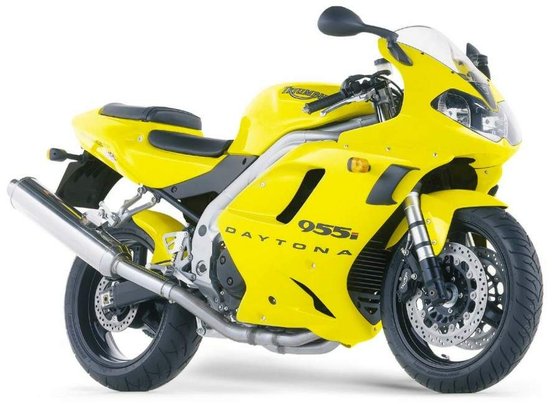
Design: British Flair Meets Function
The Daytona 955i’s design ethos screams “rebel with a cause.” While competitors opted for twin-spar frames, Triumph stuck with a tubular aluminum perimeter frame that’s both lightweight and strikingly industrial.
Evolutionary Tweaks
- Single-Sided Swingarm: Reintroduced in 2002 after a brief hiatus, this signature feature isn’t just for show. It simplifies wheel changes and adds visual drama, especially on the Centennial Edition’s carbon-fiber-adorned models.
- Aerodynamic Refinement: By 2004, Triumph sharpened the fairing lines, added color-matched air intakes, and fitted a sleeker seat cowl. The result? A bike that looks fast standing still.
- Color Schemes: From the Centennial’s Aston Green (a nod to British Racing Green) to the SE’s Tornado Red, the Daytona’s palette was as bold as its performance.
Riding Experience: Track Weapon, Road Companion
Swing a leg over the Daytona, and the first thing you notice is the 815 mm (32.1-inch) seat height. It’s tall, placing your hips high for aggressive cornering, but the ergonomics strike a surprising balance. The bars are slightly raised compared to earlier models, reducing wrist strain on long rides.
On the Twisties
- Flickable, Not Twitchy: The 22.5-degree rake and 1426 mm (56.1-inch) wheelbase lend stability at speed without sacrificing agility. Transitioning between corners feels intuitive, though the 188 kg (414 lb) dry weight is noticeable in tight hairpins.
- Suspension Savvy: Fully adjustable 45mm forks and a monoshock soak up bumps while remaining taut enough for track use. Dial in 10% more preload on the rear, and the Daytona carves like a scalpel.
- Braking Bite: Twin 320mm front discs with four-piston calipers deliver ferocious stopping power. Initial bite is strong yet progressive—no wooden feel here.
Highway Comfort
Surprisingly, the Daytona isn’t a torture rack on long hauls. The seat is firm but supportive, and the windscreen deflects most turbulence at 120 km/h (75 mph). Just don’t expect touring-bike relaxation—the engine’s heat can toast your thighs in summer traffic.
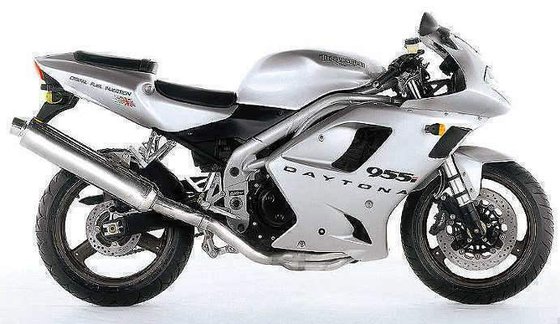
Competition: How Does It Stack Up?
In the early 2000s, the Daytona 955i faced fierce rivals. Here’s how it holds up:
vs. Honda CBR900RR Fireblade (2002)
- Fireblade Strengths: Lighter (186 kg / 410 lbs), sharper turn-in, and a reputation for reliability.
- Daytona’s Edge: Superior mid-range torque, a more soulful engine note, and exclusivity. The Fireblade blends in; the Daytona stands out.
vs. Suzuki GSX-R750 (2003)
- GSX-R Advantages: 20 kg (44 lbs) lighter, telepathic handling, and a screaming 750cc inline-four.
- Daytona’s Reply: The triple’s torque advantage makes it less reliant on revs. Need to overtake? Just twist the throttle—no downshifts required.
vs. Yamaha YZF-R1 (2004)
- R1’s Claim to Fame: 150 hp, cutting-edge geometry, and a race-ready pedigree.
- Daytona’s Counter: A more engaging riding experience. The R1 feels clinical; the Daytona feels alive.
Maintenance: Keeping the Triple Thriving
Owning a Daytona 955i isn’t just about riding—it’s about stewardship. Here’s what to watch:
Key Service Points
- Valve Adjustments: Every 12,000 km (7,500 miles). Clearances are tight: 0.10–0.20 mm (0.004–0.008 in) for intake, 0.20–0.30 mm (0.008–0.012 in) for exhaust.
- Oil Changes: Use 15W/40 synthetic (3.2 liters with filter). Neglect this, and the triple’s top end will protest.
- Cooling System: Flush coolant every 2 years. The 2.8-liter system is compact, so air pockets can form—bleed carefully.
- Chain Care: The O-ring chain needs regular lubrication. MOTOPARTS.store’s high-performance chain lubes reduce wear on the 18/42 sprocket setup.
Upgrade Recommendations
- Exhaust: Swap the stock can for a MOTOPARTS.store high-mount carbon fiber exhaust. It shaves weight and amplifies the triple’s snarl.
- Brake Pads: Upgrade to sintered pads for sharper bite and better heat resistance.
- Tires: Modern rubber like Michelin Power 5s transform grip. Stick with the stock 120/70-17 front and 190/50-17 rear sizes.
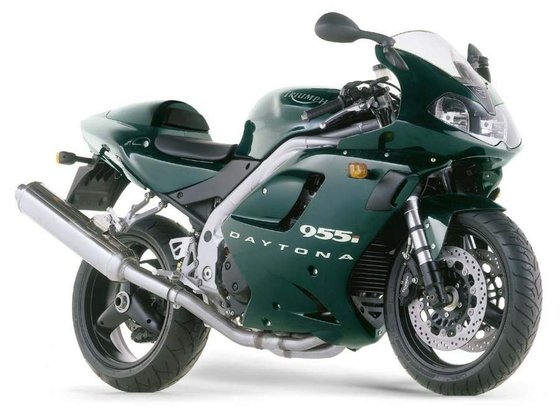
Conclusion: A Modern Classic
The Triumph Daytona 955i is more than a relic—it’s a testament to doing things differently. Its triple-cylinder engine delivers a unique blend of grunt and grace, while the chassis balances aggression with everyday usability. Yes, it’s heavier than its Japanese rivals, and yes, parts like the single-sided swingarm demand meticulous care. But ride one, and you’ll understand why owners become evangelists.
For those lucky enough to own one, MOTOPARTS.store stands ready to keep your Daytona thriving. From forged pistons to period-correct decals, we’ve got the passion (and parts) to match yours.
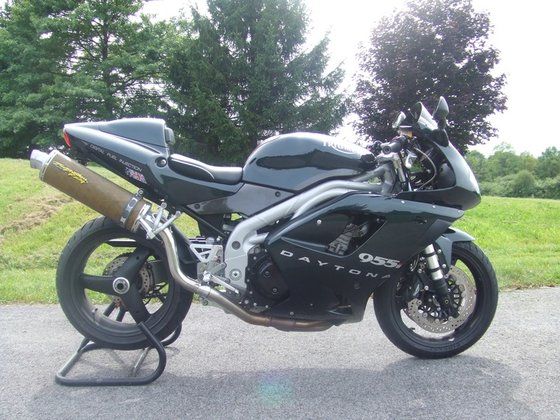








Specifications sheet
| Engine | |
|---|---|
| Stroke: | Four-stroke |
| Max power: | 110 kW | 148.0 hp |
| Max torque: | 100 Nm |
| Fuel system: | Multipoint sequential electronic injection |
| Max power @: | 10700 rpm |
| Spark plugs: | NGK DPR8EA-9 |
| Displacement: | 955 ccm |
| Max torque @: | 8200 rpm |
| Configuration: | Inline |
| Spark plug gap: | 0.6 |
| Compression ratio: | 12.0:1 |
| Number of cylinders: | 3 |
| Dimensions | |
|---|---|
| Wheelbase: | 1426 mm (56.1 in) |
| Dry weight: | 188 |
| Wet weight: | 209 |
| Seat height: | 815 mm (32.1 in) |
| Overall width: | 725 mm (28.5 in) |
| Overall height: | 1165 mm (45.9 in) |
| Overall length: | 2072 mm (81.6 in) |
| Fuel tank capacity: | 21 L (5.5 US gal) |
| Drivetrain | |
|---|---|
| Final drive: | chain |
| Chain length: | 106 |
| Transmission: | 6-speed |
| Rear sprocket: | 42 |
| Front sprocket: | 18 |
| Maintenance | |
|---|---|
| Engine oil: | 15W40 |
| Brake fluid: | DOT 4 |
| Coolant capacity: | 2.8 |
| Forks oil capacity: | 1.2 |
| Engine oil capacity: | 3.2 |
| Engine oil change interval: | Every 5000 km or 2 years, whichever comes first |
| Valve clearance (intake, cold): | 0.10–0.20 mm |
| Valve clearance check interval: | 24,000 km / 15,000 mi |
| Valve clearance (exhaust, cold): | 0.20–0.30 mm |
| Recommended tire pressure (rear): | 2.6 bar (38 psi) |
| Recommended tire pressure (front): | 2.2 bar (32 psi) |
| Chassis and Suspension | |
|---|---|
| Rake: | 22.5° |
| Frame: | Tubular fabricated aluminium alloy perimeter |
| Trail: | 79 mm (3.1 in) |
| Rear tire: | 190/50 z-17 |
| Front tire: | 120/70 z-17 |
| Rear wheel: | 17 x 6.0 in alloy 3-spoke |
| Front wheel: | 17 x 3.5 in alloy 3-spoke |
| Rear brakes: | Single 220 mm disc, 2-piston caliper |
| Front brakes: | 2 x 320 mm discs, 4-piston calipers |
| Rear suspension: | Monoshock, adjustable preload, compression, and rebound damping |
| Front suspension: | 45mm telescopic forks, adjustable preload, compression, and rebound damping |



